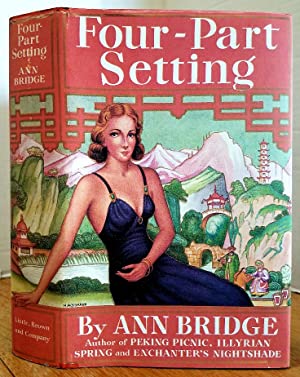Lady Harriet’s Ultimate China Bookshelf – courtesy of Anne Bridge’s Four-Part Setting (1939)
Posted: June 11th, 2023 | No Comments »The great novelist of expatriate Peking between the wars, Ann Bridge (best known for Peking Picnic), wrote Four-Part Setting in 1939, though it is set a decade previously – late 1920s…
Fleeing from her failed marriage, Rose Pelham seeks sanctuary in Peking, China, with her cousins, Anastasia and Antony Lydiard. The romantic attentions of Captain Hargreaves are a welcome distraction from her woes, but in the society of Anglicised 1920’s Peking, it is hard for such relationships not to draw notice and create scandal.
Among the Legation Quarter types she encounters is Lady Harriet – and Lady Harriet has opinions on who anyone arriving in Peking should read….Rose is in deparate need of schooling having ‘only read two or three books about the Empress Dowager…’ And so the books ‘strewn about Lady Harriet’s sitting-room…’
‘Backhouse and Bland, the Abbe Huc, Giles, and more modern ones like Rodney Gilbert, “La Chine en folie”, and a set of paperbound volumes in Italian, Vare’s Novelle di Yenching, which Lady Harriet has especially commended to her, “my dear, he’s really the Kipling of China.”‘
So, Lady Harriet’s Ultimate China Bookshelf (and where authors have multiple titles I’ve opted for the ones most widely rewad by the Peking foreign colony):
Sir Edmund Backhouse and JOP Bland, China Under the Empress Dowager (1910)
Everiste Regis Huc (aka Abbe Huc), Travels in Tartary, Thibet and China During the Years 1844-1846, (English translation, W. Hazlitt), (1851)
Herbert Giles (many possibles but let’s opt for…) China and the Chinese (1902)
Rodney Gilbert, What’s Wrong With China? (1926)
Daniele Vare, The Novels of Yenching (by which Lady Harriet means the famed Italian diplomats colected novels – The Maker of Heavenly Trousers, The Gate of Happy Sparrows, and The Temple of Costly Experience)
Bridge rather falls down here on her timeline of the late 1920s as these books were published in 1926 and then 1936 and 1937 respectively – but, she does note Lady Harriet has ‘paperbound volumes’ in Italian – early proofs? She is well connected enough)

Leave a Reply